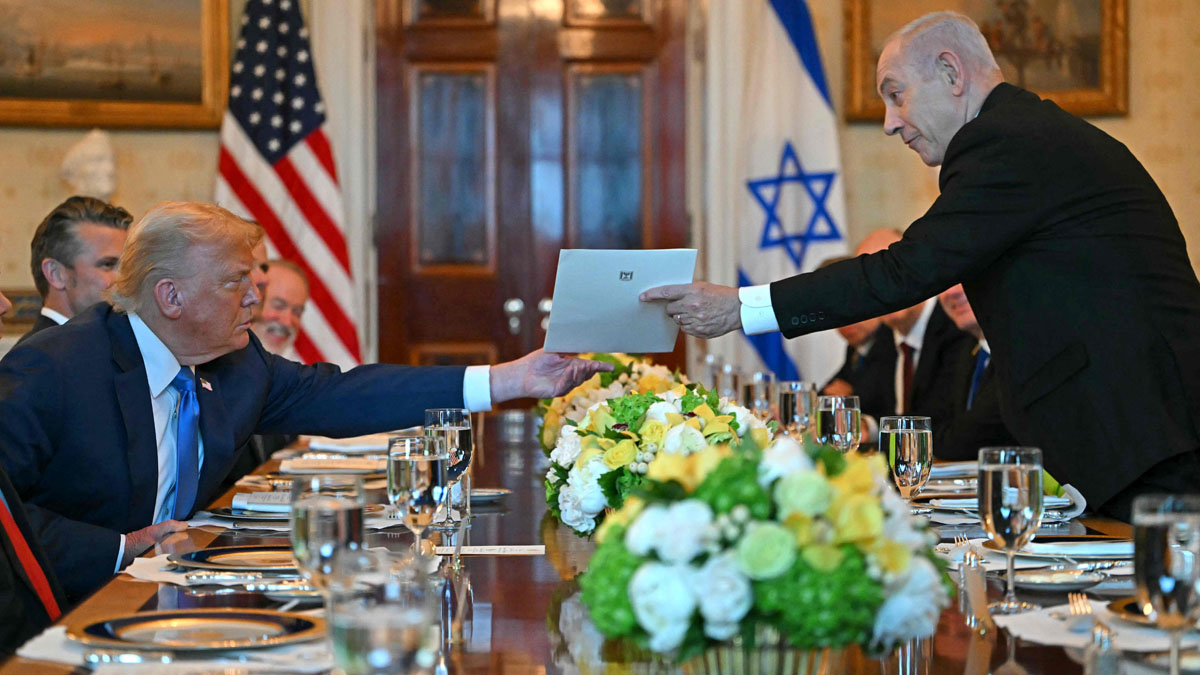Netanyahu returns from Washington without ceasefire deal, as Gaza talks stall
 TOPSHOT - Israeli Prime Minister Benjamin Netanyahu (R) hands over a letter to US President Donald Trump as they meets at the Blue Room of the White House in Washington, DC, on July 7, 2025. Prime Minister Netanyahu will meet Monday with President Trump, who expressed hope for a "deal this week" between Israel and Hamas that sees hostages released from the Gaza Strip. Indirect negotiations between Israel and Hamas began on July 6 in Doha, aiming to broker a ceasefire and reach an agreement on the release of hostages in exchange for Palestinian prisoners. (Photo by ANDREW CABALLERO-REYNOLDS / AFP)
TOPSHOT - Israeli Prime Minister Benjamin Netanyahu (R) hands over a letter to US President Donald Trump as they meets at the Blue Room of the White House in Washington, DC, on July 7, 2025. Prime Minister Netanyahu will meet Monday with President Trump, who expressed hope for a "deal this week" between Israel and Hamas that sees hostages released from the Gaza Strip. Indirect negotiations between Israel and Hamas began on July 6 in Doha, aiming to broker a ceasefire and reach an agreement on the release of hostages in exchange for Palestinian prisoners. (Photo by ANDREW CABALLERO-REYNOLDS / AFP)
Prime Minister Benjamin Netanyahu returned to Israel yesterday without a ceasefire agreement with Hamas, despite days of high-level talks in Washington with US officials, including President Donald Trump. Hopes of a breakthrough had been raised earlier in the week, with optimistic statements from both Israeli and American sides, but key issues remained unresolved.
At the centre of the deadlock are disputes over the duration of the truce, the extent of Israeli military withdrawal from Gaza and how humanitarian aid would be delivered during any cessation of hostilities. Mediators from the US, Egypt and Qatar are yet to find consensus on these core points.
Before departing, Netanyahu said he was working toward a 60-day ceasefire that would see Hamas release around half of the estimated 50 hostages still held in Gaza, including both living captives and the bodies of the deceased. However, he insisted that any truce would not lead to a permanent arrangement unless Hamas disarmed and Gaza was demilitarised. He stated that negotiations to end the war must depend on “the minimal conditions: Hamas lays down its arms, Gaza is demilitarised, there are no longer any governing or military capabilities of Hamas.”
Hamas swiftly rejected this condition. Basem Naim, a senior Hamas official, said in a text message that disarmament would “never” be part of the negotiations.
A key sticking point remains the question of how far Israeli forces would withdraw during a truce. Hamas demands a full withdrawal from the Gaza Strip, but Israel has proposed maintaining a military presence in parts of the territory, particularly in southern Gaza. Defence Minister Israel Katz reportedly discussed plans to convert parts of southern Gaza into a zone for displaced Palestinians, sparking backlash from critics who likened it to a modern-day concentration camp.
While ceasefire talks continued in Doha, there were fresh reports of violence in Gaza. Fares Afaneh, a rescue official in northern Gaza, said an Israeli strike hit a former school in Jabaliya that had been repurposed as a shelter. Nine people were reported killed. The Israeli military said it had targeted a key Hamas operative based at the site. The Gaza health ministry warned that hospitals were running out of fuel, leading to the suspension of vital services.
Netanyahu’s latest visit to Washington marked his third since Trump’s return to the White House. The trip featured several high-profile meetings and gestures of political alignment, including calls for Trump to be nominated for the Nobel Peace Prize. The Israeli PM repeatedly claimed a deal was close, telling journalists on Wednesday that he anticipated a 60-day ceasefire in which “the first batch [of hostages]” would be released.
However, by Thursday, no agreement had been finalised. Trump’s special envoy to the Middle East, Steve Witkoff, postponed a planned trip to Doha, acknowledging that the talks had not progressed sufficiently.
The US reportedly pushed back against Israeli plans to maintain control over significant parts of Gaza. Witkoff had privately compared one such proposal to the “Smotrich plan,” referencing hardline Finance Minister Bezalel Smotrich. Israel later submitted a revised version to make it more acceptable to Washington.
Still, Hamas raised objections on other fronts, including whether the Israeli- and US-backed Gaza Humanitarian Fund would continue to operate. The UN reported on Friday that nearly 800 people had been killed attempting to access GHF distribution sites since May. Hamas also objected to Israel’s refusal to commit to a permanent truce, a position US mediators tried to address by offering informal guarantees for an extended ceasefire beyond the initial 60 days.
Netanyahu’s visit, though short on diplomatic gains, appeared to strengthen his political standing. It seems to have reinforced the image of unity between him and Trump at a time when Netanyahu faces mounting pressure at home from a fragile coalition and a corruption trial that was again postponed due to his travel.
Meanwhile, US Secretary of State Marco Rubio announced sanctions on Francesca Albanese, a UN expert on the Palestinian territories, for her call to the International Criminal Court to investigate Israeli officials and US companies over the Gaza conflict. Though Trump had voiced frustration with Israel’s role in escalating regional tensions, describing the situation as one in which “they don’t know what the fuck they’re doing”, both leaders managed to present a united front during the visit.
Middle East